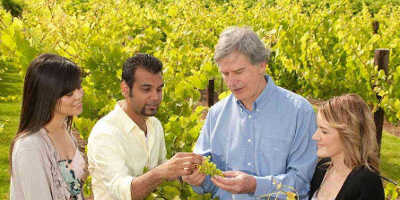Penfolds Grange – the Barossa Valley’s most expensive wine
Written by: Cameron Ward
Published: 10/04/2019
Reading time: 3 mins
Everyone loves a winner, right? Penfolds in the Barossa Valley has been producing some of the world’s best wine for over 65 years.
If you’re anything like us you’re probably not surprised to learn that your go-to $9 bottle of red isn’t the best wine in the world. However, you can find one of the best at Penfolds cellar door in the Barossa Valley. Penfolds Grange is Australia’s most revered wine. From rocky beginnings, this shiraz vintage is the pinnacle of wine making in the Valley.
In 1957 chief winemaker Max Schubert showed his first experimental wine, the 1951 Grange. Much to his shock, it was universally disliked. The wine was deemed so undrinkable that one doctor suggested that it would be a fantastic anaesthetic for his patients.
After it’s shocking reception, the winery management told Schubert to stop the project. Determined to reach his vision, Schubert continued to make the wine in secret for three years. He stashed the bottles in the deepest parts of the Penfolds cellars in the hope that he wouldn’t be caught. In 1960, the Penfolds board ordered Grange back into production. The wines from the three secret years are now referred to as the ‘Hidden Grange’ and are the rarest bottles available.
Since the reintroduction of Grange by the Penfolds board in 1960, Grange has continued to evolve and set the highest standard for red wine not just in Australia, but around the world.
Setting records
As Grange is a wine best cellared – left to ferment over a considerable length of time – decades-old bottles are regularly sold at auction. In 2018 a bottle of 1951 Grange set the Australian record, selling for $67,000AUD ($78,000 including buyer’s premium). Believed to be one of only 20 bottles remaining, the wine is past its peak for drinking, but it is commonly sought by wealthy collectors and wine connoisseurs as an addition to their collection, and not for drinking.
1951 Grange has become so valuable because, although it was bottled, it was never commercially released. Max Schubert gave some to friends and family, but the rest remained as museum stock, further contributing to their significant value today.
Typically, as wines age, they are worth more at auction. However, good weather conditions and variations in grape type percentage year-on-year can also change a bottle’s value. 30 and 40-year anniversaries also tend to increase the price a bottle will sell for. Additionally, collectors may look for specific bin numbers. The bin number refers to the areas in which the wine has been stored before being commercially released. Bottles produced during years when the Grange has been stored outside of bin 65 may attract a higher auction price
A taste of perfection
With bottles starting at a cool $900 you might not be able to afford yourself in a bottle of Grange. However, that doesn’t mean you won’t ever get a taste.
A visit to Penfolds Barossa Valley cellar door leads you to the A Taste of Grange Experience. Not only will you taste some of Penfolds best wines but also be given a rare chance to taste Grange itself.
Whether you’re a connoisseur in the making or just enjoy a glass with dinner it’s easy to see why Penfolds Grange has become so significant in Australian wine making. Head to Penfolds cellar door in the Barossa Valley to learn more about the spectacular history behind this impeccable wine.
Related article: What Makes the Whispering Wall in the Barossa Valley So Special?




